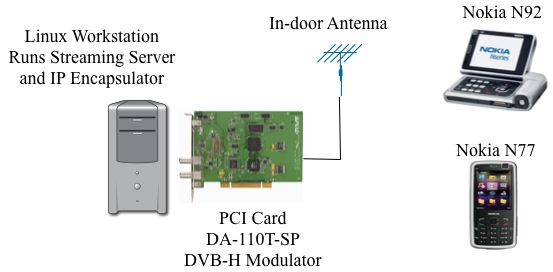Streaming to Wireless and Mobile Devices
Wireless networks offer convenience,mobility, and low cost infrastructure. As wireless networks provide higher throughput and quality-of-service (QoS), video streaming over wireless networks has become an important application. The optimization of video streaming over wireless networks, however, is a challenging task because of the heterogeneity and dynamic nature of the channels among wireless nodes. In this project, we seek to optimize the quality of video streaming in wireless networks with energy-constrained devices. We consider a general wireless network model, in which there are multiple wireless stations sharing a common wireless medium. These wireless stations can, for example, be notebook computers, PDAs, or video sensors. The wireless media can include cellular networks, IEEE 802.16 WiMAX networks, and IEEE 802.11 WLANs. The wireless stations can be sending and/or receiving video streams to/from the video server through a wireless base station. For example, in video surveillance systems, video sensors captures and transmit their streams over a WLAN to a processing server for further analysis. As another example, wireless stations can be receiving video tutorials, demos, or movies from a video-on-demand streaming server over a WiMAX network.
We consider battery-powered wireless stations that have power constraints. To cope with the power constraints, stations employ complexity scalable video coders that may selectively skip some encoding optimization modules to save power. To maximize quality at a given power budget, we employ models that relate power consumption, encoding bit rate, and resulting distortion. Power considerations are critical in wireless devices. Previous measurement studies indicate that modern video coders consume about two-thirds of the system power in video wireless communication systems
We are also interested in video broadcasting to mobile devices in systems such as DVB-H (Digital Video Broadcast--Handheld). These systems provide TV services to mobile devices. We are working on algorithms to broadcast IP packets to mobile devices such that their wireless reception components can sleep for the longest possible period of time (and hence save energy) while maintaining good video quality.
People
- Cheng-Hsin Hsu (PhD student)
- Yi Liu (MSc student)
Publications
- C. Hsu, M. Hefeeda, Power-aware Video Streaming in 802.11 Wireless LANs, under review.
Mobile TV (DVB-H) Testbed and Experiments
This testbed is used to evaluate several of our algorithms that aim to improve mobile TV quality and usability. We configure a commodity Linux workstation as our streaming server as well as IP encapsulator that converts a video over IP stream into a MPEG-2 transport stream. This Linux workstation also hosts a PCI-based DVB-H modulator card that is connected to an in-door antenna. We currently use Nokia N92 mobile phone as TV receivers, which enables us to gather several performance metrics such as video quality, CPU loads, and energy consumption (battery-life). In particular, this testbed consists of:
- An Intel Quad-Core Xeon E5420 (2.5 GHz) PC running Ubuntu Linux.
- A Dektec DTA-110T DVB-T/H Modulator and UHF Upconverter for PCI Bus.
- A Nokia N-92 mobile TV phone.
- Open source IP encapsulator software from http://amuse.ftw.at/downloads/encapsulator .
Discussion and Ideas
- Extend power awareness to WiMax and TDMA networks.
References and Links
- Wing-TV Project: Docs to test and to verify in detail the DVB-H specification.
- J. Wang, M. Venkatachalam, and Y. Fang, System Architecture and Cross-Layer Optimization of Video Broadcast over WiMAX, IEEE JSAC 25(4), pp. 712--721, MAY 2007. (Check this special issue of JSAC as well.)
- G. Gardikis, G. Xilouris, C. Skianis, Broadband multimedia on the move with DVB-H, Multimedia Tools and Applications, 36(1-2), January 2008. (DVB-H tutorial in inter-active mode.)

